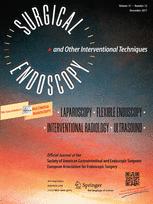Rinsma NF, Smeets FG, Bruls DW, Kessing BF, Bouvy ND, Masclee AA, Conchillo JM
Surg Endosc. 2014 Mar;28(3):941-9.
OBJECTIVES:
Transoral incisionless fundoplication (TIF) is a new endoscopic treatment option for gastroesophageal reflux disease (GERD). The mechanisms underlying the anti-reflux effect of this new procedure have not been studied. We therefore conducted this explorative study to evaluate the effect of TIF on reflux mechanisms, focusing on transient lower esophageal sphincter relaxations (TLESRs) and esophagogastric junction (EGJ) distensibility.
METHODS:
GERD patients (N = 15; 11 males, mean age 41 years, range 23-66), dissatisfied with medical treatment were studied before and 6 months after TIF. We performed 90-min postprandial combined high-resolution manometry and impedance-pH monitoring and an ambulatory 24-h pH-impedance monitoring. EGJ distensibility was evaluated using an endoscopic functional luminal imaging probe before and directly after the procedure.
RESULTS:
TIF reduced the number of postprandial TLESRs (16.8 ± 1.5 vs. 9.2 ± 1.3; p < 0.01) and the number of postprandial TLESRs associated with reflux (11.1 ± 1.6 vs. 5.6 ± 0.6; p < 0.01), but the proportion of TLESRs associated with reflux was unaltered (67.6 ± 6.9 vs. 69.9 ± 6.3 %). TIF also led to a decrease in the number and proximal extent of reflux episodes and an improvement of acid exposure in the upright position; conversely, TIF had no effect on the number of gas reflux episodes. EGJ distensibility was reduced after the procedure (2.4 ± 0.3 vs. 1.6 ± 0.2 mm(2)/mmHg; p < 0.05).
CONCLUSIONS:
TIF reduced the number of postprandial TLESRs, the number of TLESRs associated with reflux and EGJ distensibility. This resulted in a reduction of the number and proximal extent of reflux episodes and improvement of acid exposure in the upright position. The anti-reflux effect of TIF showed to be selective for liquid-containing reflux only, thereby preserving the ability of venting gastric air.
Link to abstract on PubMed: Rinsma NF, et al; Surg Endosc. 2014 Mar;28(3):941-9.


